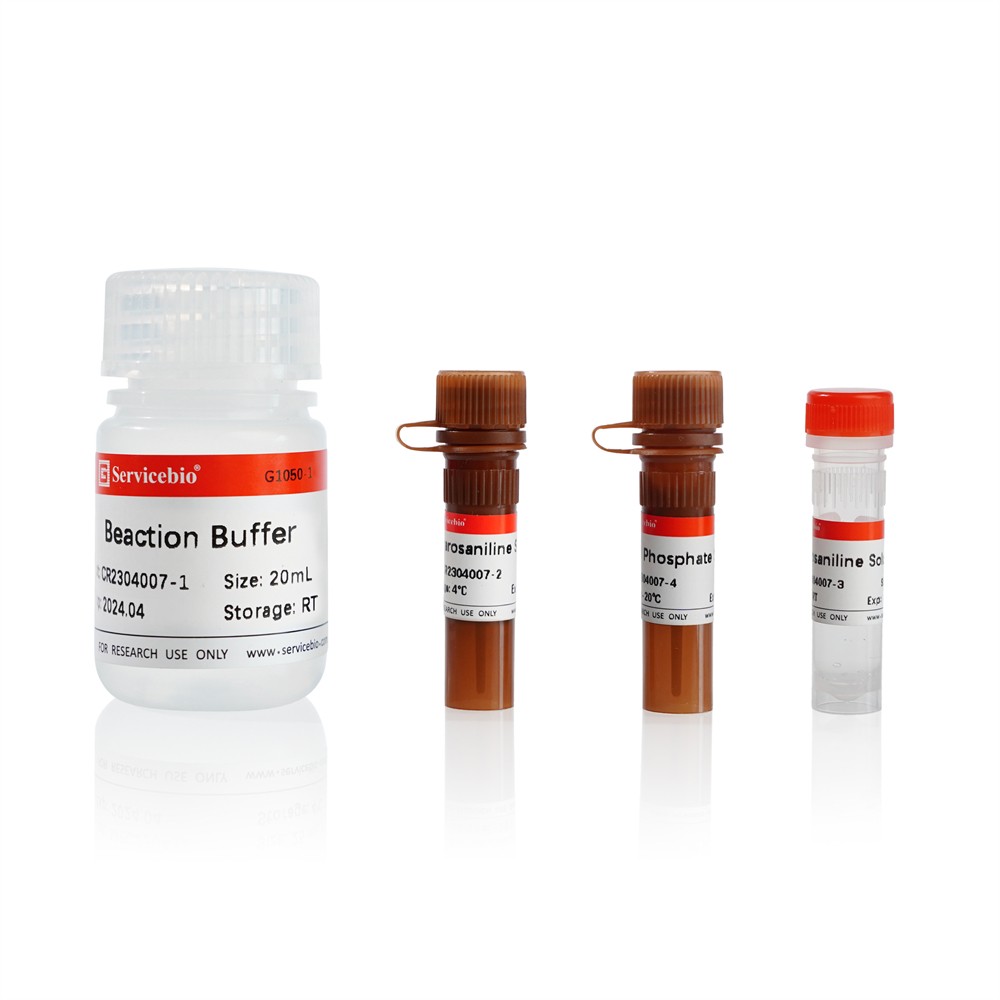


Product Information
|
Product Name |
Cat.No. |
Spec. |
|
TRAP Staining Kit |
AO-03-G1050-50T |
50 T |
Description
Tartrate resistant acid phosphatase (TRAP) is the signature enzyme of osteoclasts, which is specifically distributed in osteoclasts. TRAP staining kit is used to visualize osteoclasts in tissues. The basic principle is that under acidic conditions containing tartaric acid, anti-tartaric acid phosphatase TRAP can hydrolyze naphthol AS-BI phosphate, and the resulting naphthol AS-BI binds to hexaazole-pararosaniline to form a non-water-soluble burgundy substance deposited in the enzyme-activated in-situ site, which realizes the chromatography and localization of anti-tartaric acid phosphatase.
The basic components of the product: the main components of the reaction buffer are acetic acid buffer and potassium sodium tartrate, pH about 5.0; pararosaniline solution, containing pararosaniline; the main component of sodium nitrite solution is 4% sodium nitrite; AS-BI phosphate substrate solution, the main component is 20 mg/mL naphthol AS-BI phosphate. After staining with this product, TRAP in osteoclasts was Burgundy and localized in the cytoplasm. According to the amount of 300 μL per tissue spot on the slice, the kit can do more than 50 TRAP stainings.
Storage and Handling Conditions
Wet ice transportation; Store at 2-8℃ and avoid light, in which AS-BI phosphate substrate solution is stored at -20℃, valid for 12 months.
Component
|
Component Number |
Component |
AO-03-G1050-50T |
|
G1050-1 |
Acetic acid buffer solution & Potassium sodium tartrate |
20 mL |
|
G1050-2 |
Pararosaniline solution |
1 mL |
|
G1050-3 |
Sodium nitrite solution |
1 mL |
|
G1050-4 |
AS-BI Phosphate Solution |
1 mL |
|
Product Manual |
||
Assay Protocol
Preparation Before Experiment
Prepare TRAP working fluid:
(1) Take 50 μL pararosaniline solution (G1050-2) and 50 μL sodium nitrite solution (G1050-3) and mix them in a clean centrifuge tube to get hexaazole-pararosaniline solution;
(2) Add 100 μL AS-BI phosphate substrate solution (G1050-4) to 100 μL hexaazole-pararosaniline solution in step 1, and blow and aspirate several times to fully;
(3) Absorb 1.8 mL reaction buffer (G1050-1) and add it to the mixture solution in step 2 mix thoroughly;
(4) The mixed liquid in step 3 is filtered through a needle filter (0.45 μm stream filter film) to obtain the TRAP working liquid.
Note: Be sure to prepare the working solution in the order it belongs to. About 200-300 μL of working solution is required for each tissue point, which should be prepared according to the amount used and used as needed to avoid waste.
Paraffin Sectioning Procedure (For Reference)
1. Paraffin sections are dewaxed to water and washed in pure water for several minutes.
2. Put the sections in a tissue chemical pen circle (with a certain amount of pure water to prevent the drying of sections) in a wet box, and incubate the sections with pure water at 37℃ for 2 h.
3. After the section is incubated, pour out pure water, add filtered TRAP working solution to cover the tissue, and place it at 37 °C in the dark for 20-30 min.
4. (Optional, prepare your own reagents) Counterstain the nuclei: pour the incubation solution and wash it with hematoxylin dye solution to stain the nuclei.
5. Dehydrate, transparent, and seal with neutral gum.
Operation Procedure of Cell Slide (For Reference)
1. Cell fixation: remove the cell culture medium by suction, add 4% paraformaldehyde (G1101 recommended) and fix for 15-30 min, then wash with distilled water for 3 times.
2. Cell membrane rupture: Cells were covered with 0.2% Triton X-100 solution for 20-30 min and gently washed with distilled water for 3 times.
3. Incubation and staining: TRAP working solution was added to the cell well plate to cover the cells, and the cells were incubated at 37℃ for 15-20 min in the dark, and washed with distilled water for 3 times.
4. (Optional, prepare your own reagents) Nuclear counterstaining: Blot the incubation solution and wash it with hematoxylin staining solution for nuclear staining.
5. Add an appropriate amount of absolute ethanol for dehydration, take out the cover glass in the well plate, dry it with a hair dryer, and seal it upside down on the clean glass slide with neutral gum.
For Research Use Only!
Use collapsible tabs for more detailed information that will help customers make a purchasing decision.
Ex: Shipping and return policies, size guides, and other common questions.